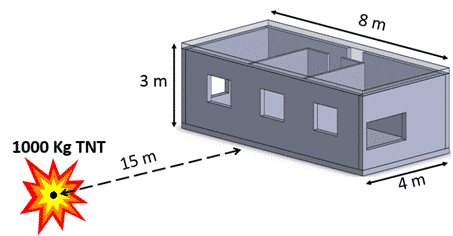The numerous benefits of small scale laboratory experiments include shorter preparation and execution times, cheaper materials, usage of measurement devices that cannot be employed in field tests and a compactness that often allows for more controlled test conditions and provide high repeatability. The exploding wire technique has been employed successfully in the simulation of small blast-structure interactions (Ram & Sadot, 2012). By discharging a large capacitor on a thin piece of wire, a scaled-down explosion can be simulated in laboratory conditions. As for a test case, the load developed on an inside door of a one story building was investigated. Figure 1 illustrate the set scenario: a 1000 kg TNT explosion detonated 15m from the façade of a building. The blast wave penetrates the building, propagating inside and loading the tested door. The actual dimension of the setup are presented in the figure. In the small scale setup the exploding wire generates a blast wave from a TNT equivalent of about 60-100 mg. In order to conserve the scaling laws (Cranz-Hopkinson scaling law) we found that with this 100 mg TNT the building size would be too small, introducing other dominant physical effects such as viscosity. Therefore, the need to increase the charge produced by the exploding wire system becomes crucial. Various methods have thus far been experimented to achieve the desired higher values, such as metallurgic adjustments and the design of additional auxiliary structures. Numerical analysis using the LS-DYNA software has offered both validation of progress and guidance in choosing a course of exploration. So far geometrical configurations have been found to be effective. Tests were conducted with a rectangular reflector and compared to CONWEP, experiments and numerical simulations. In figure 2, the pressure and impulse histories are plotted. We noted that although the generated pressure profile isn’t correctly mimicked, the impulse is well matched. Further modifications to the existing wire technique will be presented, in addition to a summary of results and conclusions.

Figure 1: Full scale scenario of a 1 ton TNT explosion a distance of 15 meters from the facade of a target building.
Figure 2: Pressure histories of two repeated experiments using a tunnel structure around the exploding wire. Comparison to CONWEP prediction and numerical simulation shows good agreement.
Reference
Ram, O., & Sadot, O. (2012). Implementation of the exploding wire technique to study blast-wave-structure interaction. Experiments in Fluids, 53(5), 1335-1345. doi:10.1007/s00348-012-1339-8

